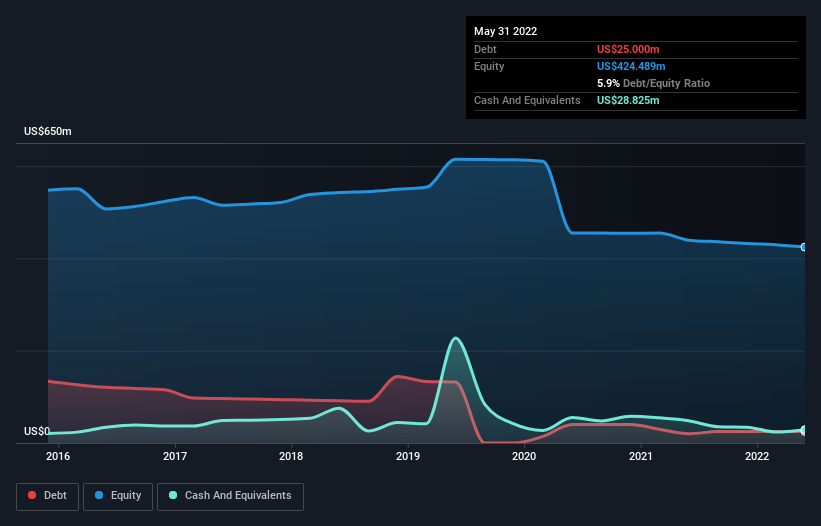- United States
- /
- Medical Equipment
- /
- NasdaqGS:ANGO
Is AngioDynamics (NASDAQ:ANGO) Using Debt In A Risky Way?

Warren Buffett famously said, 'Volatility is far from synonymous with risk.' When we think about how risky a company is, we always like to look at its use of debt, since debt overload can lead to ruin. As with many other companies AngioDynamics, Inc. (NASDAQ:ANGO) makes use of debt. But should shareholders be worried about its use of debt?
What Risk Does Debt Bring?
Generally speaking, debt only becomes a real problem when a company can't easily pay it off, either by raising capital or with its own cash flow. Part and parcel of capitalism is the process of 'creative destruction' where failed businesses are mercilessly liquidated by their bankers. However, a more usual (but still expensive) situation is where a company must dilute shareholders at a cheap share price simply to get debt under control. Of course, debt can be an important tool in businesses, particularly capital heavy businesses. The first step when considering a company's debt levels is to consider its cash and debt together.
View our latest analysis for AngioDynamics
What Is AngioDynamics's Net Debt?
The image below, which you can click on for greater detail, shows that at May 2022 AngioDynamics had debt of US$25.0m, up from US$20.0m in one year. However, it does have US$28.8m in cash offsetting this, leading to net cash of US$3.83m.

How Healthy Is AngioDynamics' Balance Sheet?
We can see from the most recent balance sheet that AngioDynamics had liabilities of US$74.3m falling due within a year, and liabilities of US$53.9m due beyond that. On the other hand, it had cash of US$28.8m and US$56.5m worth of receivables due within a year. So its liabilities outweigh the sum of its cash and (near-term) receivables by US$42.9m.
Given AngioDynamics has a market capitalization of US$839.4m, it's hard to believe these liabilities pose much threat. But there are sufficient liabilities that we would certainly recommend shareholders continue to monitor the balance sheet, going forward. While it does have liabilities worth noting, AngioDynamics also has more cash than debt, so we're pretty confident it can manage its debt safely. The balance sheet is clearly the area to focus on when you are analysing debt. But ultimately the future profitability of the business will decide if AngioDynamics can strengthen its balance sheet over time. So if you're focused on the future you can check out this free report showing analyst profit forecasts.
In the last year AngioDynamics wasn't profitable at an EBIT level, but managed to grow its revenue by 8.7%, to US$316m. We usually like to see faster growth from unprofitable companies, but each to their own.
So How Risky Is AngioDynamics?
Statistically speaking companies that lose money are riskier than those that make money. And in the last year AngioDynamics had an earnings before interest and tax (EBIT) loss, truth be told. Indeed, in that time it burnt through US$11m of cash and made a loss of US$27m. While this does make the company a bit risky, it's important to remember it has net cash of US$3.83m. That means it could keep spending at its current rate for more than two years. Summing up, we're a little skeptical of this one, as it seems fairly risky in the absence of free cashflow. There's no doubt that we learn most about debt from the balance sheet. However, not all investment risk resides within the balance sheet - far from it. Be aware that AngioDynamics is showing 2 warning signs in our investment analysis , and 1 of those is potentially serious...
At the end of the day, it's often better to focus on companies that are free from net debt. You can access our special list of such companies (all with a track record of profit growth). It's free.
New: Manage All Your Stock Portfolios in One Place
We've created the ultimate portfolio companion for stock investors, and it's free.
• Connect an unlimited number of Portfolios and see your total in one currency
• Be alerted to new Warning Signs or Risks via email or mobile
• Track the Fair Value of your stocks
Have feedback on this article? Concerned about the content? Get in touch with us directly. Alternatively, email editorial-team (at) simplywallst.com.
This article by Simply Wall St is general in nature. We provide commentary based on historical data and analyst forecasts only using an unbiased methodology and our articles are not intended to be financial advice. It does not constitute a recommendation to buy or sell any stock, and does not take account of your objectives, or your financial situation. We aim to bring you long-term focused analysis driven by fundamental data. Note that our analysis may not factor in the latest price-sensitive company announcements or qualitative material. Simply Wall St has no position in any stocks mentioned.
About NasdaqGS:ANGO
AngioDynamics
A medical technology company, engages in the design, manufacture, and sale of medical, surgical, and diagnostic devices for the use in treating peripheral vascular disease, and oncology and surgical settings in the United States and internationally.
Flawless balance sheet and fair value.


